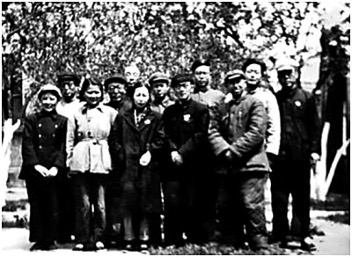Du Zijin
Du Zijing, 1897-1955, also known as Du Tongli, was from Xihua County, Henan.
In the early years of the Republic of China, Du Zijing entered the Henan Higher Normal School in Kaifeng. After graduating, he taught Chinese literature at various preparatory schools for studying abroad in Europe and America.
In 1921, Du Zijing enrolled in the Chinese Literature Department of Beijing Normal University, studying under renowned teachers such as Qian Xuantong and Li Jinxi, and achieved excellent results. During his time at school, he served as a major contributor to the “National Language Weekly” and published poetry, novels, and essays under the pen names “Tongli” and “Du Tongli” in magazines such as “Oriental Magazine,” “Student Magazine,” “Morning Post Supplement,” and “Language Thoughts.”
After graduating in 1925, Du Tongli worked as a Chinese literature teacher at Kaifeng First Normal School and Kaifeng Women’s Normal School for over 20 years. His students remarked that he “taught through both words and deeds, serving as a model for others.” During this period, he also edited “Four Tone Easy Access,” proposing a clear and efficient approach to language teaching and phonetics research. The famous writer Li Rui regarded Du Zijing as a “model akin to Zhu Ziqing.”
Du Zijing was deeply influenced by his teacher Qian Xuantong and advocated for the reform and simplification of Chinese characters. In July 1928, he delivered a speech on “The Issue of New Chinese Characters” at the “National Language Romanization Seminar” in Henan. He was a member of the “National Language Romanization Promotion Association” and also a lecturer in the association’s “National Language Romanization Seminar,” but later advocated for the modification of Romanization towards a Latinization direction and published “On Improving National Language Romanization.”
In February 1930, Du Zijing was appointed as a member of the Henan Province Phonetic Symbol Promotion Committee, participating in the formulation of the “Phonetic Symbol Implementation Plan,” helping establish training centers, publishing books and newspapers, and supervising inspections.
In 1949, Du Zijing was reassigned to work with the Textbook Editing Committee of the Central People’s Government, later transferred to the National Language Group of the Central Textbook Editing Committee as an editor, where he collaborated with Zhu Wenshu and others to compile the “Junior High School Language Textbook” (six volumes).
On April 17, 1950, with the support of the Chinese Script Reform Association, “Guangming Daily” launched the weekly magazine “New Language and Literature,” with Du Zijing, Cao Bohan, Sun Fuyuan, and Chen Jianzhong serving as editorial committee members. This was one of the earliest publications in the country to use the term “language and literature.”
In August 1950, Du Zijing joined the Xinhua Dictionary Publishing House, becoming one of the earliest editorial staff members and the head of the data group. Xiao Jialin and others edited and published the “Commonly Used Vocabulary” (1953) and the first edition of the “Xinhua Dictionary.”
On May 21, 1955, Du Zijing passed away due to liver disease.

In April 1951, a group photo of staff from the Xinhua Dictionary Publishing House (Du Zijing is the first on the left in the back row).
Linguistic Works:
“Collection of Essays on Chinese Character Reform in 1949” - Popular Bookstore (1950)
“Summary of Papers on Chinese Language Issues in 1950” - Popular Bookstore (1952)
Linguistic Papers:
“The New Character Issues in China Over the Past Five Years” (World Daily, National Language Weekly, 1931)
“The Publication of Common Characters in National Pronunciation” (World Daily, National Language Weekly, 1932)
“Monthly Chronicle of New Character Issues in China” (1930-1932) (World Daily, National Language Weekly, 1933)
“Common Characters Used Under the Imperial Edict” (World Daily, National Language Weekly, 1934)
“A Symbolic Language” (Shandong Public Education Series, Volume 5, Issue 10)
“Monthly Chronicle of New Character Issues in China” (1933) (World Daily, National Language Weekly, 1933)
“The Argumentation of Simplified Characters” - Preface to “Simplified Characters” (Shandong Public Education Series, Volume 7, Issue 3)
“Chronology of Simplified Characters” (Shandong Public Education Series, Volume 7, Issue 3)
“Compilation of Henan Dialects” (Kaifeng Normal School Journal, Issue 6)
“Brief Discussion on Abbreviated Language” (National Language Weekly, Issue 49)
“Several Issues in the Chinese Character Reform Movement” (New Construction, Volume 2, Issue 2)
“The Nature and Current Tasks of the New Language Movement” (Guangming Daily, April 17, 1950)
“Preface to ‘Collection of Essays on Chinese Character Reform in 1949’” (Guangming Daily, October 22, 1950)
“Summary of Chinese Language Issues in 1950” (Guangming Daily, 1951)
“The Issue of ‘Language’ and ‘Writing’ in Language Teaching” (Language Teaching (Tianjin), 1951, Issue 5)
“Cultural Advance of Brother Nations - The Significance of the Xikang Yi People’s Establishment of a Latinized New Script” (New Character Weekly, Issue 67)
“Chronology of the Chinese Character Reform Movement” (Language Knowledge, 1952, Issues 1-6)
“The Arrangement of Chinese Characters Must Be Simplified” (Guangming Daily, March 31, 1954)
“The Writing Deficiencies of Chinese Characters” Here is the translation of the provided text from Traditional Chinese to English:
“Point” (China Language, Issue 4, 1954)
“The Issue of Pinyinization of Chinese Characters” (China Language, Issue 11, 1954)
“Introduction to the ‘Xinhua Dictionary’” (People’s Education, Issue 2)
